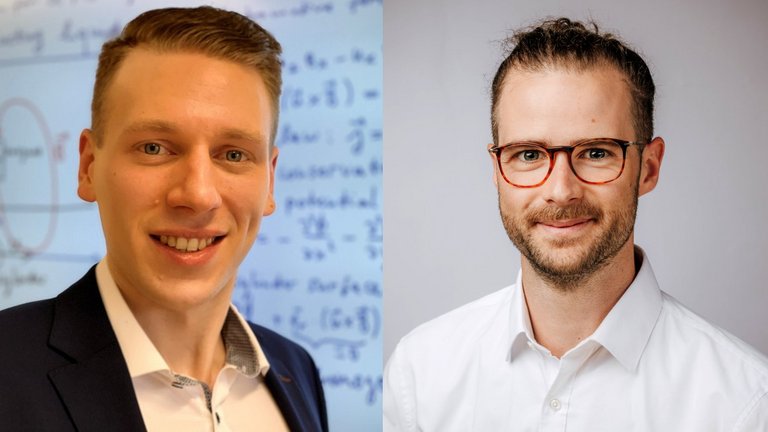For their outstanding scientific achievements in applied mathematics and fluid mechanics, Dr. Lukas Lanza and Dr. Philipp Vieweg, young scientists at TU Ilmenau, have been nominated by the Society for Applied Mathematics and Mechanics (GAMM) as GAMM Juniors. Thus, they will represent young scientists in this field for the next three years and represent their disciplines in the committees of GAMM, in science and in society. Each year, a total of ten scientists are selected as GAMM Juniors.

GAMM Juniors are international young scientists who distinguish themselves through outstanding forward-looking research achievements. In line with GAMM's guiding principle of intensifying cooperation between engineering sciences and mathematics, they are primarily intended to promote interdisciplinary dialog and knowledge transfer between the various departments of applied mathematics and mechanics. For the first time, two young scientists from the TU Ilmenau are now included in this circle.
Better understanding of geo- and astrophysical problems
How do regular flow structures arise in nature, such as cloud streets or granules, the cells of hot matter rising from the interior of stars that are visible as a honeycomb pattern on the surface? What role do these patterns play in heat transport? And how do they affect weather and climate? Dr. Philipp Vieweg is addressing these geo- and astrophysical questions in his research at the Fluid Mechanics Group, led by ERC Advanced Grant awardee Prof. Jörg Schumacher. In order to calculate and analyze the processes that lead to such structures, he uses methods of applied mathematics and machine learning.
In his recently completed doctoral thesis, for example, he numerically demonstrated the essential role of so-called thermal boundary conditions in the formation of long-lived and large-scale flow patterns in thermal convection. These are superimposed on chaotic turbulence on small scales and are found, for example, in the atmosphere, the oceans, or the interior of the Sun. He also showed how these large structures affect the turbulent global transport of momentum and heat. His direct numerical simulations required in some cases more than 130,000 CPUs (central processing units) and were carried out on supercomputing systems in Jülich and Garching, among other places.
Today, the interdisciplinarity of this research topic is more in demand than ever. "Numerical, data-driven fundamental research of simplified dynamical systems is essential for a better understanding of the complex relationships in astro- and geophysical applications," explains Dr. Vieweg. "The combination of investigations from the viewpoint of an observer moving along in the flow or a stationary observer, the so-called Lagrangian or Eulerian perspectives on fluid dynamics, generates mutually complementary insights into transport and mixing in the fluid and thus broad interest on the part of mathematicians, physicists and engineers." For example, the results can explain the hierarchy of granules and supergranules observed at the solar surface or reconstruct atmospheric flows based on weather balloon data. "These findings," Dr. Vieweg said, "are particularly important for forecasting as accurately as possible, given the perpetual changes in climate."
Safe control thanks to system data
Dr. Lukas Lanza received his PhD from the University of Paderborn under the von Mises Prize winner Prof. Thomas Berger and is currently working as a postdoctoral researcher in the Optimization-based Control Group with Heisenberg Professor Karl Worthmann at the TU Ilmenau. His field of research is mathematical systems theory, a discipline of applied mathematics without which numerous technical innovations would no longer be conceivable. He uses mathematical methods such as differential equations or data-based learning procedures to investigate how dynamic systems, such as electric drives, energy systems or traffic, can be controlled and regulated efficiently and safely. In his doctoral thesis, for example, Dr. Lanza used funnel control, a technique developed primarily at Ilmenau University of Technology, to study the stability of mechanical systems composed of several individual bodies that are connected to one another by joints or force elements such as springs or dampers.
He is continuing this research in Ilmenau with the conceptually new control methodology "Funnel MPC" (for Model Predictive Control). "An essential aspect in modern control theory is the use of system data," says Dr. Lanza. In his current research, the scientist is developing data-driven and learning-based control methods that use such system data to achieve control goals with specified accuracy: A core aspect of the development of these algorithms is that compliance with the control goals is mathematically proven and thus guarantees can be issued. A current application of this new approach is the control of a maglev train. "In this application, the main objective is to use levitation control to ensure the specified distance between the vehicle's suspension and the track," says Dr. Lanza, explaining his work. "But the system must also be robust to uncertainties and disturbances such as the total mass of the vehicle depending on the number of passengers, or operate in high winds while providing sufficient ride comfort."
About GAMM
The Society for Applied Mathematics and Mechanics was founded in 1922 by the engineer and physicist Ludwig Prandtl and the mathematician Richard von Mises. The aim of GAMM is to foster and promote scientific work and international cooperation in applied mathematics as well as in all subfields of mechanics and physics.

